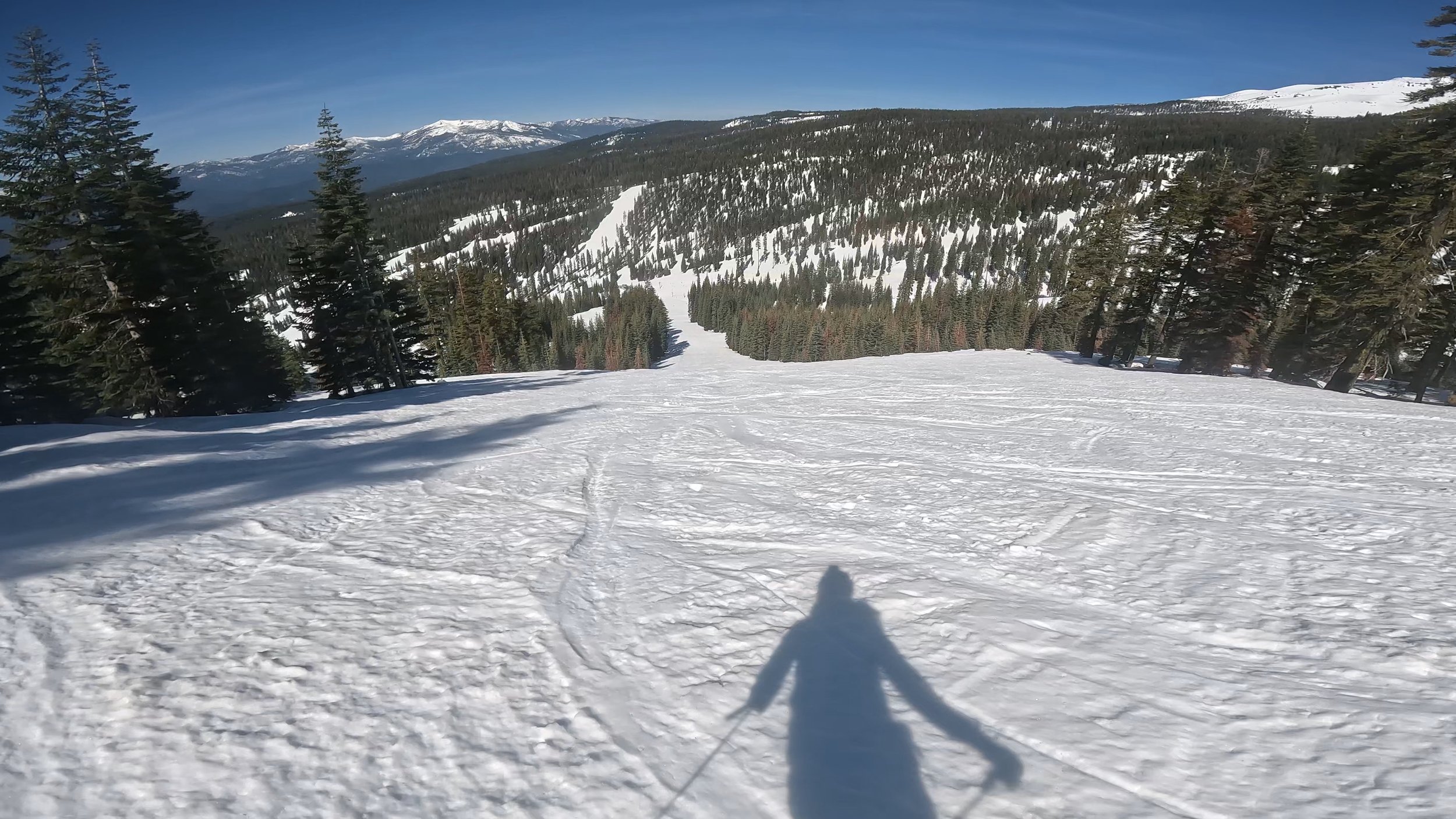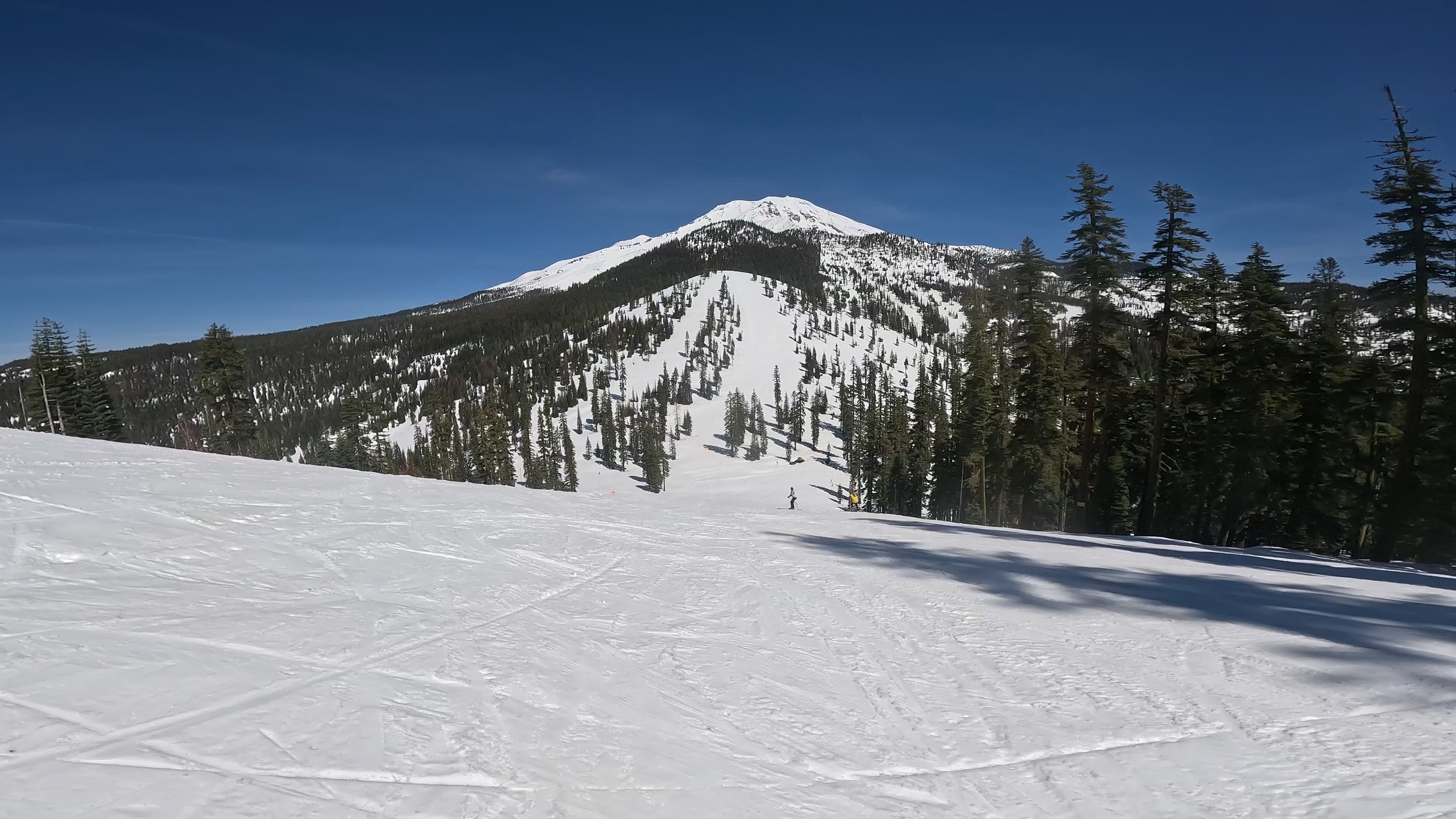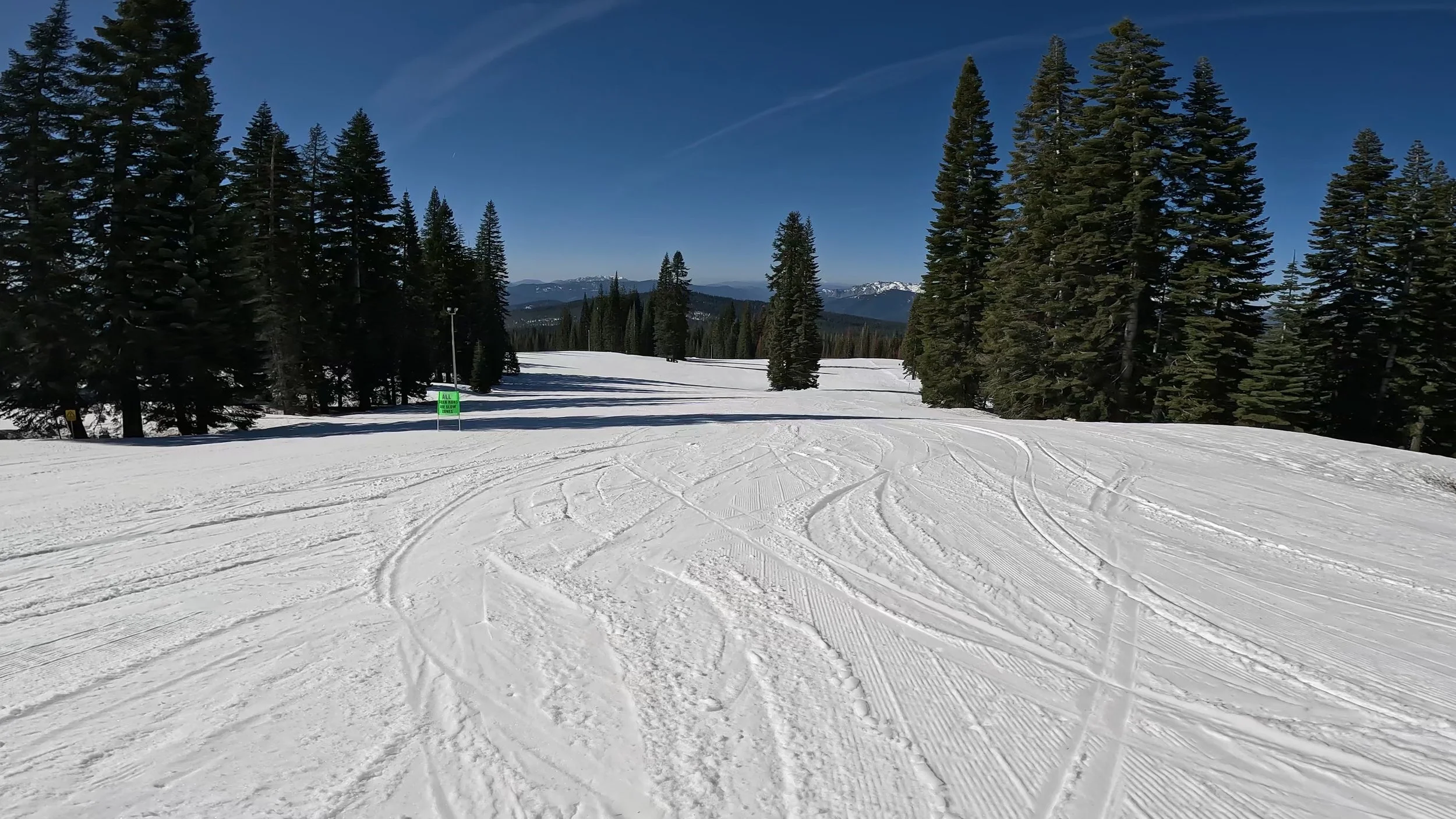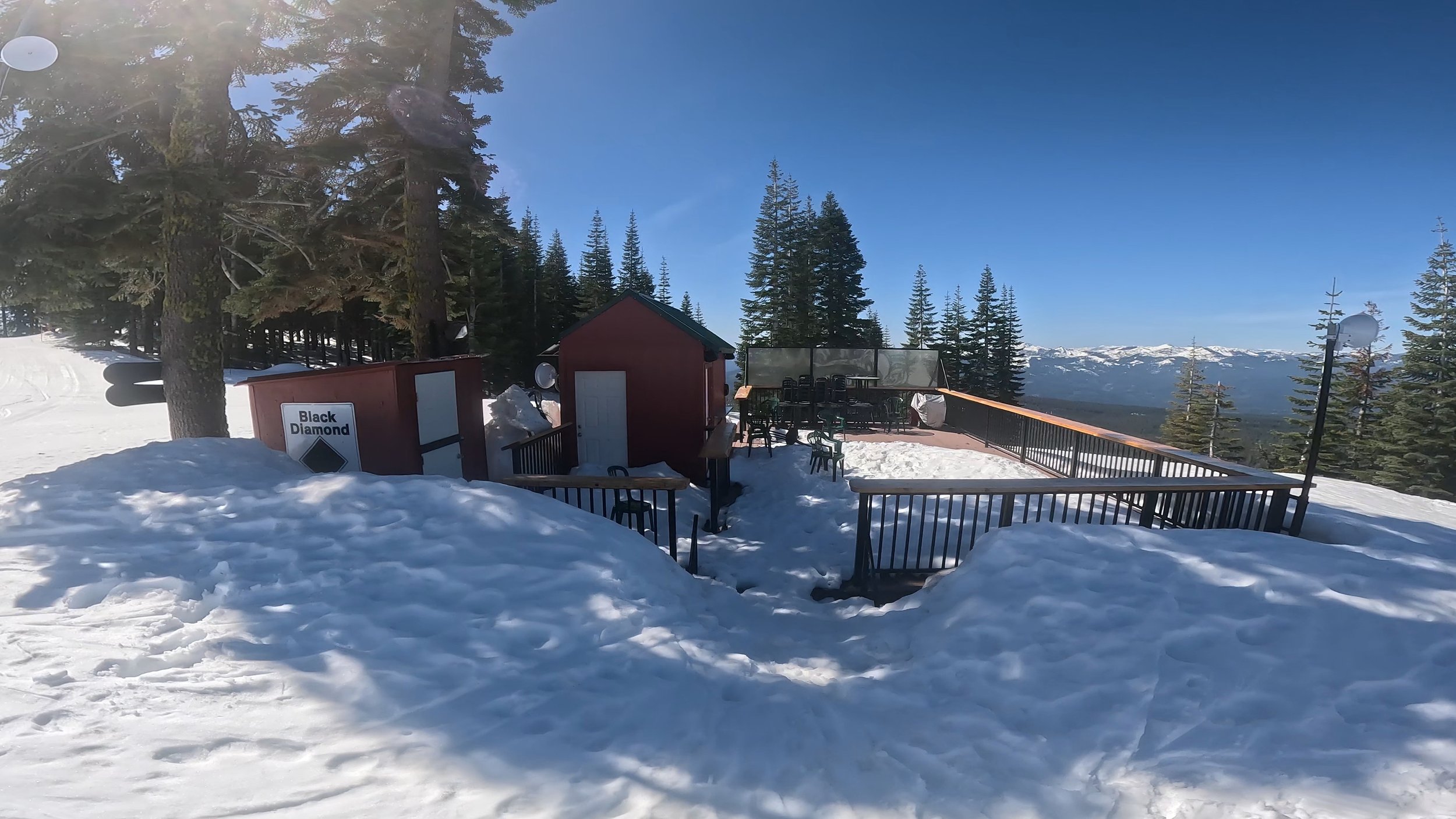Mountain Review: Mount Shasta Ski Park
MOUNTAIN SCORE
CATEGORY BREAKDOWN
See our criteria6
Snow:
5
Resiliency:
4
Size:
5
Terrain Diversity:
4
Challenge:
3
Lifts:
8
Crowd Flow:
4
Facilities:
6
Navigation:
7
Mountain Aesthetic:
GOOD TO KNOW
1-Day Ticket: $89-$99
Pass Affiliation: Indy Pass, Powder Alliance
On-site Lodging: No
Après-ski: Limited
Nearest Cities: Redding (1 hr), Sacramento (4 hrs), Eugene (4.5 hrs)
Recommended Ability Level:
+ Pros
Views of the Southern Cascades, especially up toward Shasta itself
Surprisingly reliable cover thanks to large snowmaking system and deep snowpack
Diverse selection of intermediate terrain, including glades and short bowls
Easy access to great backcountry
– Cons
Lack of true advanced and expert terrain
Slow lifts
So-so grooming
Separate peaks make for short lappable vertical drop
Major hassle to get to and from new expansion area
MOUNTAIN STATS
Lifts: 6
Trails: 38
Beginner: 20%
Intermediate: 45%
Advanced/Expert: 35%
*The new Grey Butte lift requires hiking to reach if not cutting through backcountry terrain, meaning that only 67% of Mount Shasta Ski Park’s terrain is directly lift-served without hiking required to stay in-bounds.
Mountain Review
Located on the south side of the massive Mount Shasta, Mount Shasta Ski Park is the only decently-sized California ski area north of the Tahoe region. Not to be confused with the previous Mount Shasta Ski Bowl, which closed in the 1970s due to a profoundly destructive avalanche, Mount Shasta Ski Park is a locally-focused area with some great views and great intermediate terrain—as well as a significant recent expansion.
Thanks to its namesake mountain, Shasta Ski Park may look pretty promising on paper. But does this volcano-based resort have enough going for it to justify a trip from farther away?
Mount Shasta’s snow tends to be wetter and heavier than that of the Rockies, and the resort’s south-facing exposure often makes for spring-like conditions.
Snow Quality and Consistency
Mount Shasta Ski Park gets typical California snow, meaning accumulation tends to be heavier than snow found in Utah or Colorado. However, the wetter consistency results in strong snow retention through warmer temperatures. While the resort gets a lot less snow than Tahoe area resorts, the accumulation totals are typically enough to fully cover the slopes throughout the core season, which is especially noteworthy given the ski area’s entirely southern facing exposure.
Shasta’s weather and exposure circumstances make for spring-like conditions for much of the year—and powder that gets heavy very quickly. If you’re looking for soft, untracked snow, you may be a little disappointed in the conditions you’ll find at Shasta. The resort does have a pretty extensive snowmaking system for the west, with 44% of the area being covered, allowing for a reasonably consistent opening schedule and base coverage.
Grooming
One place where Shasta has historically taken a back seat is in its grooming operations. The resort’s south-facing, spring-like slopes have always been a bit of a challenge to smooth out, and with some turnover on the grooming team since a change in ownership a few years ago, it’s common for only a few trails in each terrain pod to receive grooming on a regular basis. It’s rare that Shasta’s groomed runs will be truly unskiable, but those expecting the silky smooth corduroy that’s commonplace at almost every destination ski resort will be disappointed.
With this all being said, operations have started to improve as of this past season, with the resort investing in new grooming strategies to keep slopes in better conditions than in years’ past.
Mount Shasta Ski Park’s grooming operations are not quite up to the standards of destination ski resorts, although they’ve started to improve versus previous seasons.
Mountain Aesthetic
Thanks to its location on the slopes of Mount Shasta—a stratovolcano that tops out above 14,000 feet—the views at this ski area are impressive, both on the way up and down. On the slopes themselves, guests can see into the Klamath and Trinity Mountains, which have some striking peaks, especially in the Castle Crags area. Some slopes even offer views down to the Lassen area 70 miles away. When it comes to riding the lifts and a handful of trails, visitors will be looking up at the iconic Mount Shasta itself. Some might argue the view from the base may be the best, as the massive peak of Shasta looms above you.
What’s also above Shasta Ski Park is the old ski area on Mount Shasta, which was called Mount Shasta Ski Bowl. Ski Bowl was closed in the late 70s due to financial troubles and an avalanche that destroyed their main lift.
The ski area offers incredible vistas of Mount Shasta itself—as well as other peaks in the Southern Cascades.
Terrain Layout
The terrain at Mount Shasta Ski Park is split into four zones, each served by a dedicated lift. The bottom of the ski area also hosts a small beginner learning zone served by a magic carpet. Marmot Ridge, located to the lookers’ left of the base, accesses the resort’s longer beginner terrain and a smaller terrain park. Douglas Butte, to the lookers’ right of the base, accesses a large portion of the resort’s advanced trails and glades and a few intermediate runs as well. The Coyote Butte pod, which starts at mid-mountain, accesses additional advanced runs and glades as well as the resort’s large terrain park. Finally, the newest and highest-elevation Grey Butte pod accesses low-intermediate to advanced runs and many gladed areas. The Grey Butte area also includes Richard’s Way, which is the only double-black-diamond trail on the mountain.
TRAIL MAP
Beginner Terrain
The beginner terrain at Shasta is exclusively concentrated in the resort’s lower-mountain areas. Only the Marmot Triple and a couple of magic carpets directly serve green-rated trails; while there is one green run accessible from the Douglas and Coyote Triple lifts, it’s only accessible by taking a blue run first.
This all being said, the wide and mellow nature of the resort’s green runs makes for a solid experience for less-proficient skiers and riders, at least when the grooming allows. The first-timer carpet area is well shielded from more advanced traffic and even includes access to a small terrain park.
Mount Shasta Ski Park’s green trails are exclusive to its lower-mountain lifts.
Intermediate Terrain
Once skiers and riders move to the intermediate level, Shasta Ski Park starts to feel a lot larger thanks to moderately-sloped runs in every major area. The Grey Butte area hosts some of the ski area’s best lower-intermediate runs, including some intermediate glades, while runs off the north sides of Douglas and Coyote Buttes offer standout groomed cruising terrain.
Terrain Park
While the “Park” in the resort’s name was likely chosen to distinguish it from the old Ski Bowl, those looking for some terrain park laps will find an okay selection at Mount Shasta. Parks with smaller features can be found on Marmot Ridge as well as in the aforementioned beginner area. For medium and large features, guests should head to the Revolution park on the lower half of Coyote Butte (although it’s worth noting this park can be lapped by both the Coyote and Douglas lifts). This larger park is home to the rails, boxes, and jumps that one would probably expect from a terrain park, but it lacks the truly standout features boasted by many resorts further south in the state.
Mount Shasta Ski Park has more intermediate trails than terrain of any other ability level.
Advanced Terrain
Advanced-level skiers and riders should be able to cover the whole of Mount Shasta Ski Park without any issues. Steeper groomed trails are found on Douglas and Coyote Buttes, allowing for some serious speed runs. Coyote is home to a selection of widely-spaced advanced glade runs, as well as an open, bowl-like summit that lasts for a few hundred feet. Longer bump runs can also be found on these two peaks, with the Rocky Ridge trail especially standing out for its moguls. On especially good snow days, the lightly-gladed and south-facing Backside zone on Douglas Butte offers wide-open glades with excellent views.
Shasta’s black runs tend to fall on the easier side for their difficulty ratings. Those used to blues at destination resorts, such as those in Tahoe, shouldn’t have a problem completing most of them.
Mount Shasta Ski Park’s glades are arguably home to its most standout advanced terrain.
Expert Terrain
If you’re looking for a serious challenge, Shasta Ski Park is not for you. There is one double-black trail within the whole ski area—Richard’s Way—and while it has some rocky obstacles, the steep section is very short. In addition, this run is frustrating to lap due to a long, flat exit. Some of the trees on Douglas Butte also offer some expert-level obstacles, especially between Rocky Ridge and West Face; however, these obstacles are tough to track down and easy to avoid.
Backcountry
While its in-bounds terrain may not be too technical, one of the best parts of Mount Shasta Ski Park is its easy access to incredible backcountry terrain. From the top of Grey Butte, guests can hike or skin up to higher terrain on Mount Shasta itself, which extends more than 6,000 feet above the highest-elevation point of the resort. Skinning up the face of Mount Shasta and then skiing or riding back into the ski area can be really fun for those looking to do longer laps.
RECOMMENDED SKIS FOR MOUNT SHASTA SKI PARK
NOTE: We may receive a small affiliate commission if you click on the below links. All products listed below are unisex.
Recommended intermediate ski
Recommended advanced ski
Recommended high-alpine ski
Recommended powder ski
Access to and from Grey Butte Expansion Terrain
On paper, Mount Shasta Ski Park offers a vertical drop of over 2,000 feet—which, while not class-leading, is decent for California. However, this metric is a bit misleading, as one cannot do a true top-to-bottom run without hiking or entering backcountry terrain.
The peak of the ski area is served by the new Grey Butte Quad lift, and while it looks like the “Get Back” run on the map allows for easy escape from the pod, this trail is very flat, uphill in some areas, and longer than you think (at nearly a half mile). Getting to the pod requires the same traverse—meaning some uphill catwalking in the other direction—or entering backcountry terrain off the backside of Coyote Butte. That backcountry terrain is very tempting, as you can see the Grey Butte lift the whole time, but if you enter it know that it is out of bounds and is steep enough for avalanches to occur. This weird situation is largely due to checkerboarded land ownership, and while Shasta Ski Park says it’s working toward a solution, one has yet to be implemented.
Shasta’s Grey Butte area might be the most bizarrely integrated terrain zone of any ski resort we’ve ever visited. Unless you want to enter backcountry terrain, an uphill catwalk is required to get both in and out of this area.
Navigation
Other than getting to Grey Butte, getting around Shasta Ski Park is pretty easy. Both base lifts are easy to access when first entering the resort, and there are very few traverses. A handful of trails do involve some flat sections, most notably the beginner Panther Creek run from the bottom of the Coyote Butte chair to the base area and the catchline out of the glades on the south side of Douglas Butte; however, the resort is straightforward overall.
Mount Shasta Ski Park has a mid-mountain rest stop, but it lacks indoor seating and isn’t always open.
Facilities
Shasta offers a few options for those looking to stop in for a break. The main base offers typical ski area food, with a few extra food items such as poutine, and prices are about average for what you get. There is also a nice bar with easy access to the patio overlooking the mountain, though you’ll be mostly in the shade of the building since the slopes are facing south. On the mountain itself, there is a place to stop on the top of Douglas Butte, though it’s very small, lacks indoor seating, and isn’t always open. There is also a rest area at the base of Gray Butte with a vending machine and an outhouse.
All of Mount Shasta Ski Park’s lifts are slow, and all except Grey Butte lack safety bars.
Lifts and Crowd Flow
While all the chairlifts at Shasta are slow, fixed grip chairs, they generally offer sufficient capacity for the mountain’s needs. Marmot, Coyote, and Douglas are all comfortable triple chairs, though modest lines can build up at Douglas due to this zone’s popularity. Grey Butte, the resort’s newest lift, is a very comfy quad chair. It’s just about guaranteed that Grey Butte will never have a line due to its high capacity and hard to get to nature.
Night Skiing
Mount Shasta offers “twilight skiing” on Fridays and Saturdays, extending lift operations until 7pm and 6pm, respectively. Operations only occur on a few runs off the Marmot and Douglas areas, which are marked accordingly on the trail map. This offers a few extra hours on busy days for locals to get some turns after work, or for visitors to maximize their day on the slopes.
Mount Shasta’s very remote location means it takes over four hours to reach from the nearest major cities.
Getting There and Parking
Mount Shasta is in far northern California, about four hours north of Sacramento and four hours south of Eugene, Oregon. The nearest international airports are in San Francisco and Portland, but by that point, you’re looking at five- or six-hour drives. However, once you make the drive, parking at Mount Shasta is very close to the base and free.
RECOMMENDED SNOWBOARDS FOR MOUNT SHASTA SKI PARK
NOTE: We may receive a small affiliate commission if you click on the below links. All products listed below are unisex.
Recommended intermediate board
Recommended advanced board
Recommended high-alpine board
Recommended powder board
Lodging
As a locally-oriented ski area, Mount Shasta Ski Park doesn’t offer any on-site lodging. Luckily, the closest town of Mount Shasta is only about 20 minutes away, and visitors will find many lodging options and an eclectic vibe there. Options range from basic inns to three-star hotels
Après-ski
If you’re looking for a place to party after shredding the slopes, Mount Shasta Ski Park is not the best bet. The base bar, while very nice and large, doesn’t stay open much past the chairs closing.
Mount Shasta Ski Park has a bar at the base area with outdoor seating, but a true après vibe is fairly lacking.
Verdict
If you’re looking for gnarly terrain, high speed lifts, or impeccably groomed trails, you won’t find that at Mount Shasta Ski Park. What you will find are mellow slopes with soft snow, limited lift lines, a bizarre recent expansion, and convenient access to some really good backcountry. The resort probably isn’t worth going out of your way to visit, but if you happen to be in the area, it may be worth a stop by.
Pricing
Prices at Mount Shasta are much cheaper than other California resorts, with tickets topping out at $99 for holidays and $89 on weekends, although some might argue this is still only an okay value for the quality of slopes you get. Shasta is also on the Indy Pass and Powder Alliance, which offer a limited number of days at each member ski area.



























